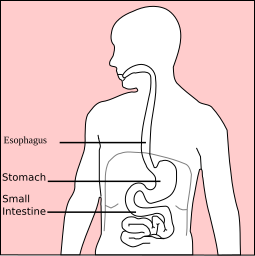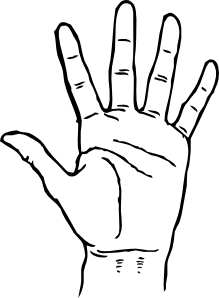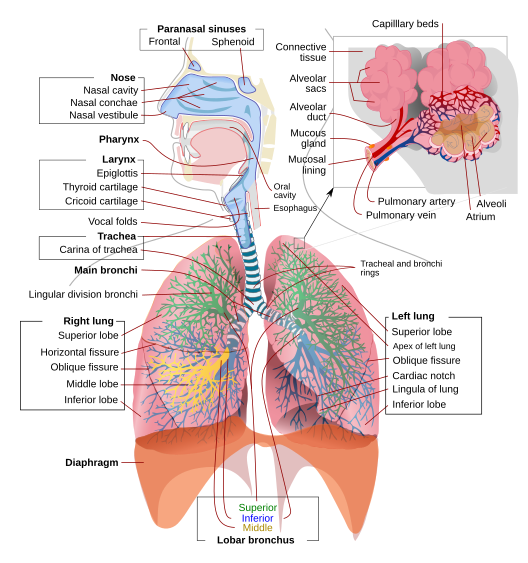Parts of the Body

Human Body
The human body mostly consists of a head, neck, stomach, two arms, two legs, knee, two hands, ankle and, feet as well as numerous internal organ groups such as respiratory, circulatory and a central nervous system.
Numerous internal organ groups such as:
Respiratory system - The respiratory system is the anatomical system of an organism that introduces respiratory gases to the interior and performs gas exchange. In humans and other mammals, the anatomical features of the respiratory system include airways,lungs, and the respiratory muscles.
Circulatory system - The circulatory system is an organ system that passes nutrients (such as amino acid,electrolytes and lymph), gases, hormones, blood cells, etc. to and from cells in the body to help fight diseases and help stabilize body temperature and pH to maintain homeostasis. This system may be seen strictly as a blood distribution network, but some consider the circulatory system as composed of the cardiovascular system, which distributes blood.

Central Nervous system - The nervous system is an organ system containing a network of specialized cells called neurons that coordinate the actions of an animal and transmit signals between different parts of its body. In most animals the nervous system consists of two parts, central and peripheral.

Parts of the Head

Head - is the upper portion of the human body. It supports the face and is maintained by the skull, which itself encloses the brain.
Hair - is a filamentous bio-material, that grows from follicles found in the dermis. Found exclusively in mammals, hair is one of the defining characteristics of the mammalian class.
Forehead - is the fore part of the head. It is, formally, an area of the head bounded by three features, two of the skull and one of the scalp. The top of the forehead is marked by the hairline, the edge of the area where hair on the scalp grows.
Temple - indicates the side of the head behind the eyes. The bone beneath is the temporal bone as well as part of the sphenoid bone.
Eye - are organs that detect light and convert it to electro-chemical impulses in neurons. The simplest photo-receptors in conscious vision connect light to movement. Eyes with resolving power have come in ten fundamentally different forms, and 96% of animal species possess a complex optical system.
Eyebrow - is an area of thick, delicate hairs above the eye that follows the shape of the lower margin of the brow ridges of some mammals. Their main function is to prevent sweat, water, and other debris from falling down into the eye socket, but they are also important to human communication and facial expression.
Eyelash - or simply lash is one of the hairs that grow at the edge of the eyelid. Eyelashes protect the eye from debris and perform some of the same function as whiskers do on a cat or a mouse in the sense that they are sensitive to being touched, thus providing a warning that an object (such as an insect or dust mite) is near the eye (which is then closed reflexively).
Ear - is the organ that detects sound. It not only receives sound, but also aids in balance and body position. The ear is part of the auditory system.
Earlobe - is composed of tough areolar and adipose (fatty) connective tissues, lacking the firmness and elasticity of the rest of the pinna. Since the earlobe does not contain cartilage it has a large blood supply and may help to warm the ears and maintain balance.
Cheek - constitute the area of the face below the eyes and between the nose and the left or right ear. They may also be referred to as jowls. "Buccal" means relating to the cheek. In humans, the region is innervated by the buccal nerve.
Nose - is a protuberance in vertebrates that houses the nostrils, or nares, which admit and expel air for respiration in conjunction with the mouth. Behind the nose are the olfactory mucosa and the sinuses.
Nostril - is one of the two channels of the nose, from the point where they bifurcate to the external opening. In birds and mammals, they contain branched bones or cartilages called turbinates, whose function is to warm air on inhalation and remove moisture on exhalation.
Mouth - is the first portion of the alimentary canal that receives food and saliva. The oral mucosa is the mucous membrane epithelium lining the inside of the mouth. In addition to its primary role as the beginning of the digestive system, in humans the mouth also plays a significant role in communication. While primary aspects of the voice are produced in the throat, the tongue, lips, and jaw are also needed to produce the range of sounds included in human language.
Jaw - is any opposable articulated structure at the entrance of the mouth, typically used for grasping and manipulating food. The term jaws is also broadly applied to the whole of the structures constituting the vault of the mouth and serving to open and close it and is part of the body plan of most animals.
Chin - is the lowermost part of the face.It is formed by the lower front of the mandible.People show a wide variety of chin structures.The chin developed as a point of muscular attachment facilitating minute movements of the lips associated with speech.
Lip - are a visible body part at the mouth of humans and many animals. Lips are soft, movable, and serve as the opening for food intake and in the articulation of sound and speech. Human lips are a tactile sensory organ, and can be erogenous when used in kissing and other acts of intimacy.
Parts of the Neck
Neck - The neck protects your spinal cord and spinal nerves, while supporting and balancing the weight of your head. Poor posture, wear and tear, injury, stress, and tension can strain or damage vital parts of your neck.
Parts of the Arm

Arm - is the part of the upper limb between the shoulder and the elbow joints. In other animals, the term arm can also be used for analogous structures, such as one of the paired forelimbs of a four-legged animal or the arms of cephalopods.
Scapula - is the bone that connects the humerus (upper arm bone) with the clavicle (collar bone). The scapula forms the posterior (back) located part of the shoulder girdle. In humans, it is a flat bone, roughly triangular in shape, placed on a posterolateral aspect of the thoracic cage.
Humerus - is a long bone in the arm or forelimb that runs from the shoulder to the elbow. Anatomically, it connects the scapula and the lower arm (consisting of the radius and ulna), and consists of three sections. The upper extremity consists of a rounded head, a narrow neck, and two short processes (tubercles, sometimes called tuberosities.)
Ulna - is one of the two long bones in the forearm, the other being the radius. It is prismatic in form and runs parallel to the radius, which is shorter and smaller.
Radius - is one of the two large bones of the forearm, the other being the ulna. It extends from the lateral side of the elbow to the thumb side of the wrist and runs parallel to the ulna, which exceeds it in length and size. It is a long bone, prism-shaped and slightly curved longitudinally.
Elbow
Elbow - is the region surrounding the elbow-joint the ginglymus or hinge joint in the middle of the arm. Three bones form the elbow joint: the humerus of the upper arm, and the paired radius and ulna of the forearm.The bony prominence at the very tip of the elbow is the olecranon process of the ulna, and the inner aspect of the elbow is called the antecubital fossa.
Parts of the Stomach

Stomach - is a muscular, hollow, dilated part of the alimentary canal which functions as an important organ of the digestive tract in some animals, including vertebrates, echinoderms,insects (mid-gut), and molluscs. It is involved in the second phase of digestion, following mastication (chewing).
Esophagus - is an organ in vertebrates which consists of a muscular tube through which food passes from the pharynx to the stomach. During swallowing food passes from the mouth through the pharynx into the esophagus and travels via peristalsis to the stomach.
Small Intestine - is the part of the gastrointestinal tract following the stomach and followed by the large intestine, and is where much of the digestion and absorption of food takes place.
Large Intestine - is the second-to-last part of the digestive system the final stage of the alimentary canal is the anus in vertebrate animals. Its function is to absorb water from the remaining indigestible food matter, and then to pass useless waste material from the body.
Hands

Hand -is a prehensile, multi-fingered extremity located at the end of an arm or forelimb of primates such as humans, chimpanzees, monkeys, and lemurs. A few other vertebrates such as the koala (which has two opposable thumbs on each "hand" and fingerprints remarkably similar to human fingerprints) are often described as having either "hands" or "paws" on their front limbs.
Parts of the Knee

Knee -the thigh with the leg and consists of two articulations: one between the femur and tibia, and one between the femur and patella. It is the largest joint in the human body and is very complicated. The knee is a mobile trocho-ginglymus (i.e. a pivotal hinge joint), which permits flexion and extension as well as a slight medial and lateral rotation.
Parts of the Leg

Leg - is the entire lower extremity or limb of the human body, including the foot, thigh and even the hip or gluteal region; however, the precise definition in human anatomy refers only to the section of the lower limb extending from the knee to the ankle.
Ankle
Ankle - is formed where the foot and the leg meet. The ankle, ortalocrural joint, is a synovial hinge joint that connects the distal ends of the tibia and fibulain the lower limb with the proximal end of the talus bone in the foot. The articulation between the tibia and the talus bears more weight than between the smaller fibula and the talus.
Foot
Foot -is an anatomical structure found in many vertebrates. It is the terminal portion of a limb which bears weight and allows locomotion. In many animals with feet, the foot is a separate organ at the terminal part of the leg made up of one or more segments or bones, generally including claws or nails.


